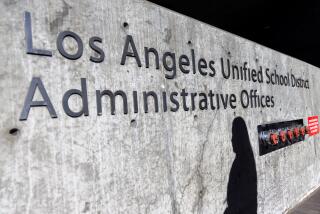Police Magnet School Plans Unveiled
Aiming to cultivate their own community-based police officers, a group of Los Angeles educators, police, city officials and business leaders Thursday announced that the cityâs first police academy magnet school programs will begin this fall.
With courses in forensic science and conflict resolution as well as regular contact with working police officers, the new high school programs will be attached to three existing law magnets and will try to draw the racially diverse student body that some critics say has been lacking at the Los Angeles Police Departmentâs training academy.
âThis is a model for the nation,â Mayor Richard Riordan said during a news conference at the Police Academy in Elysian Park, where he was flanked by six students already enrolled in the program. âIt will prepare young Angelenos for a college education and for the Police Department.â
The program is loosely patterned after a similar magnet at John F. Kennedy High School in Sacramento. Organizers said they know of no others in the country.
Each Los Angeles school--Monroe High in North Hills, Dorsey High in the Crenshaw district and Wilson High in El Sereno--will start with 30 ninth- and 10th-graders. Juniors and seniors will be added over the next two years.
âThis will really give the kids a test of what itâs like to be a police officer, I think,â said Joan Elam, principal at Monroe. âMore importantly, it will make them think about whether police work is the right work for them.â
Students are being recruited at middle and high schools, and their reaction has been enthusiastic, said Roberta Weintraub, the former Los Angeles school board member who conceived the magnet programs. âWeâve gotten a far better response than we thought we would have,â she said.
About 60 students will participate in a six-week summer program, working as interns at police stations to prepare for the fall session.
The students at Thursdayâs news conference said they expect the magnet programs to pay immediate dividends, as well as prepare them for careers.
âGoing to this school is going to give me a real boost to get into shape physically and mentally to be a good police officer and a role model for kids,â said Oganes Kuyumdzhyan, 14, of Northridge, who will attend the program at Monroe High this fall.
Dorsey High student Shameika Humphrey, 14, said she hopes to learn enough from the program to be able to deter other youngsters from joining gangs and stealing. âItâs something Iâve thought about a lot, being an officer,â she said.
Supporters hope the program will ultimately boost the number of LAPD officers who hail from Los Angeles neighborhoods and reduce the need to recruit outside the city or state.
âThis is an ideal opportunity to grow our own recruits . . . and to have people from the community work within their community,â Weintraub said.
Her proposal was embraced by officials at City Hall, the Police Department and the Los Angeles Unified School District. LAPD Deputy Chief David Gascon said the new magnets will provide the perfect opportunity for police officers to work with prospective recruits at an early age.
Councilwoman Laura Chick shepherded through the City Council a motion to allow police officers to work with the program.
âWe very much want to be recruiting young people from our own city, and this is a pool of future recruits who we can reach at an early age, especially the young girls,â said Chick, who represents the western San Fernando Valley.
The programs are being funded through a $250,000 donation from the 20th Century Insurance Co. in Woodland Hills. The donation will be used to buy equipment for physical training centers and to hire staff and grant writers to secure the money the programs will need to continue.
âNone of this would have been possible without this private funding,â said Weintraub, who will coordinate fund-raising efforts. âItâs another example of the importance of public-private partnerships to support necessary and unique programs like this.â
More to Read
Sign up for Essential California
The most important California stories and recommendations in your inbox every morning.
You may occasionally receive promotional content from the Los Angeles Times.










